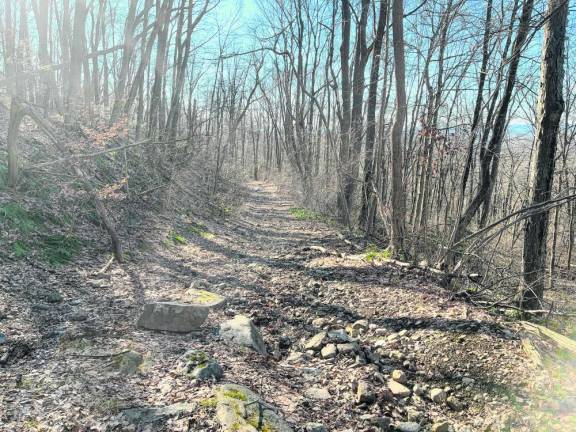
This is a story about a favorite historical hike. I love this route, which you might want to undertake yourself on a nice spring day.
One of the key antecedents of my interest in history was learning about “the old stagecoach trail ... .” Like, how is that? Where is it? I can’t believe that transport similar to the Wells Fargo wagon in the cowboy movies actually ran near my home.
The road was just beyond the William Rude family farm, extending up a hill from Route 23 and onto the cow pasture where we had played countless games of pickup baseball on warm summer days. The memory brings a smile.
One would walk up a hill that we used for sleigh riding to get to the ball field. Crossing the open grass field, where cows once stood, we walk down the path to “the brook,” where we used to hang out during summer days, a place where trees had begun to gather near moss-covered smooth rocks.
We’d go up an old “diamond drill” road left over from when the Zinc Co. was looking for a hidden magnificent ore body. Now overgrown, this old mining road always reminds me, every time I think of it, of the beautiful poem “The Path Not Taken” by the beloved Robert Frost.
The decision today is to take the lower path, the dirt course held level by the stone wall that supported its passage along the side of the hill, with the dense undergrowth of shrubs along the wetlands below.
As we get to the bottom, we pass some lifeless large old trees, with many pieces of branches on the dry basin of packed brown leaves, with broken trees - short and many leaning to the side - as if in some somber séance. This is a place we called Dead Man’s Gulch, reminiscent of an old move seen on boring, rainy Sundays on a double-digit TV channel.
Here we make a right turn through another of many stone fences. These fences were an enormous effort by the poor farmer who built them in an exertion, a self-reliant Thoreau-inspired labor, to make a living for him and his family.
We would sneak by the farm and farmhouse hoping not to be spotted, then quickly walked along one of the two well-worn tracks of the narrow buckboard wheels through the apple orchard, grabbing one or two for a somewhat sour and worm-holed snack.
The Rude family had come from ancient times in Connecticut to this rural New Jersey area in the mid-1800s. I believe the family introduced, early on, the unique Rude apple. This was another farm that had stood the test of time of 100 years or more and now had reflected to the timbre of time.
Up another rise where the steep slope of the Hamburg Mountains began to take hold, our thighs would hurt and the rock outcrops grew before us under a deep canopy of trees that prevented grass growth.
Finally, we got to “the old stagecoach road.” This was a great pleasure to see, to have been there and experienced it. Imagining those many years before when travelers came from New York City, many fresh off the boat, immigrants taking “the long brown path” as Walt Whitman would say in “Leaves of Grass.”
This path led to the inland of the great continent and the Old Northwest Territory and the gift of a new life on a new continent. This was the greater meaning of this old road, this barely recognizable pathway to new beginnings.
As time went on for me, I researched and found out that charters were made for landowners to take a toll from travelers if they maintained the land that they owned; of course, fortunate enough to be in a sequential land route that helped the flow of traffic. There were very detailed engineering regulations on standardized width, crown and sides, type of soil and pitch.
This stagecoach trail was actually known as the Paterson Hamburg Turnpike, with mile markers along the way made of red Newark Basin sandstone marking the miles from Hoboken - some of which still exist after all these years.
During the stagecoach era, roughly 1810 through 1870, this was the way to get about the nation. About 1870 in our area, the railroads came, and the commercial stagecoach lines quickly disappeared. The railroad’s importance subsided with the automobile, and as Route 23 came to be the main route about 1930, the old stagecoach trail dimmed from memory and became an overgrown vestige of an era surpassed by the march of time.
Sometime soon in the future, we will take a hike for a few miles along the stagecoach road and experience some of the places that are now off the beaten path.
Contact Bill Truran, Sussex County’s historian, at billt1425@gmail.com